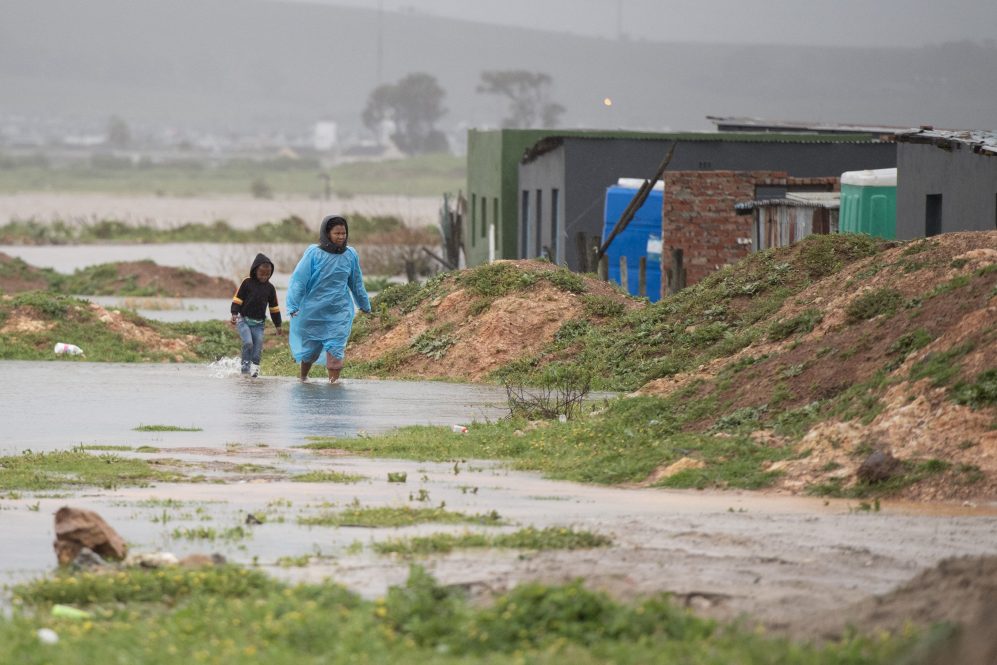In September 2023, extreme rains struck South Africa’s Western Cape province, flooding villages and leaving a trail of destruction. The catastrophic devastation is just one recent example in a string of extreme weather events that are growing more common around the world.
Fueled by rising sea surface temperatures from climate warming, torrential storms are increasing both in frequency and magnitude. Concurrently, global warming is also producing the opposite effect in other instances, as a mega-drought threatened the water supply of Cape Town in southwestern Africa to the point where residents were at risk of running out of water. This one-two punch of weather extremes are devastating habitats, ecosystems, and human infrastructure.
A team of paleoclimatologists from Syracuse University, George Mason University, and the University of Connecticut are studying an ancient source to determine future rainfall and drought patterns: fossilized plants that lived on Earth millions of years ago.
In a study published in Geophysical Research letters led by Claire Rubbelke, a Ph.D. candidate in the Department of Earth and Environmental sciences at Syracuse, and Tripti Bhattacharya, Thonis Family Professor of Earth and Environmental sciences at Syracuse, researchers zeroed in on the Pliocene epoch (~3 million years ago) – a time when conditions were very similar to today. Despite warmer temperatures, many parts of the world, including southwestern Africa, experienced dramatic increases in rainfall over land, likely caused by warmer-than-normal sea surface temperatures. This mimics a modern event called a Benguela Niño, where researchers believe shifting winds cause warm waters to move southward along the coast of Africa causing enhanced rainfall over typically arid regions.
“In the present day, the intensity and location of extreme precipitation from Benguela Niño events appear to be influenced by both Atlantic and Indian Ocean sea surface temperatures,” says Rubbelke, who is a member of Bhattacharya’s Paleoclimate Dynamics Lab. “During the Pliocene, it appears that these Benguela Niño-like conditions may have been a permanent feature.”
UConn Assistant Professor of Earth Sciences and expert in climate modeling and dynamics, Ran Feng analyzed the climate model data and specifically examined the proposed mechanism that explains the Pliocene wet conditions in southwest Africa. She says many features of ongoing climate change are reincarnations of the past warm climates. analyze the comparison data and specifically examine the proposed mechanism that explains the Pliocene wet conditions in southwest Africa. She says many features of ongoing climate change are reincarnations of the past warm climates.
“In our case, we have shown that sea surface temperature pattern surrounding South Africa is key to explaining the past hydroclimate conditions of this region,” notes Feng. “Looking into the future, how this sea surface temperature pattern may evolve has profound implications to the environmental changes in South Africa.”
The team’s work was inspired by collaborator and study co-author Natalie Burls, associate professor in the Department of Atmospheric, Oceanic and Earth Sciences at George Mason University and an oceanographer and climate scientist from South Africa who received a Ph.D. at the University of Cape Town.
“This study, which explored how past warm climates can inform us on what to expect in the future as our planet warms, brings to the fore the important role of ocean warming patterns,” says Burls. “It’s important to understand how these patterns determine the response of the hydrological cycle over Southwest Africa to global warming.”
To study the impact of climate warming on precipitation from millions of years in the past, the team analyzed “molecular fossils” in the form of ancient leaf waxes. “These are compounds produced by leaves to protect themselves from drying out,” says Bhattacharya. “They get shed from leaf surfaces and find their way to ocean sediments, where we can extract them and study their chemical composition.”
Plants use hydrogen from rainwater to produce the waxy outer coating on their leaves, which survives in ocean sediment for millions of years. The leaf wax functions as a time capsule preserved in ocean sediment.
After transporting the millions-year-old sediment from Africa to their lab in Syracuse, Rubbelke and Bhattacharya used heat and pressure to extract lipids (e.g. fat molecules), and then used a variety of solvents to isolate the exact class of molecules that they were looking to measure. From those molecules, they determined the number of different types of hydrogen present.
By comparing their data to climate models, they verify how well those models capture past climate change, which can in turn improve the accuracy of those models to predict future rainfall. As Bhattacharya notes, this is critical because climate models often disagree on whether certain regions will get wetter or drier in response to global warming.
“We are using real world data from the ancient geologic past to improve our ability to model rainfall changes as the planet warms,” she says.
As to whether the future will be wetter or drier in southwestern Africa, the team’s results suggest that both are possible, depending on where extreme sea surface temperatures are occurring.
While not much can be done to reverse climate warming, the researchers say this study illuminates the need for vulnerable communities to have the tools and resources to adapt to these seemingly more frequent extreme weather events.



